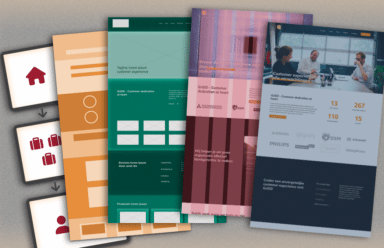
How to ensure an optimal customer experience at your organization?
Thinking about the customer experience of your organization is hot. In both the B2C and B2B world, people are increasingly realizing that an excellent customer experience is an important factor in order to be successful today and tomorrow. And so all marketing departments are investing and rushing to describe personas to represent their customer, drawing customer journeys and are altering their marketing strategies selling services, solutions or even ecosystems.
However, shouldn’t focus on customer experience be part of an organization wide strategy? In this article we take a look at why a good organisation wide strategy is needed, what is important and how to get started to ensure an optimal customer experience at your organisation.
The need for one CX strategy
According to a recent study by Dimension Data, only 13% of companies award themselves a 9 or 10 as a mark for the customer experience they offer (Dimension Data, 2017). Many respondents provide as a reason that there are different customer strategies within their organizations. The lack of alignment in these strategies causes all kinds of inconsistencies in the customer experience.
It is also typical that this research uses a self-score and not real customer data. The pain points around the customer experience are often unknown or these pain points are not linked to the performance indicators of the organization. It creates a culture where attention is focused on one indicator, such as a Net Promoter Score (NPS), without user research to really know what the root of the pain points. As a result, well-intentioned quick fixes are actually a random guess to improve the indicator.
Finally, even though organizations have persona descriptions, have a determined pain points through user research and know what the customer experience should be, it can be difficult to translate these insights into action. We often see that a small group of customer-oriented professionals are committed to an optimal customer experience, but lack support and mandate to actually change processes and culture in various business units involved.
Good customer experiences can make or break your organization
Creating a customer experience befitting your customer’s way of thinking and working offers enormous opportunities. Companies such as CoolBlue, Bunq, Tesla and Sungevity have each managed to capture a position in highly competitive fields by putting the customer experience at the heart of their organizations. Even the more traditional organizations are transforming their business models into solutions in which products are offered “as a service” to match customer needs, for instance: you can now go to the Dutch national railway organization (NS) for mobility solutions.
Finally, we see companies that use their ecosystem to compete on customer experience. An example is the smart thermostat that can also be used to control your lighting and switch on your alarm system. It offers the customer benefits that a competitor without that ecosystem cannot provide.
Example of bad CX: rigid customer processes
A striking example of bad customer experience are rigid customer process we recently experienced when opening a business account with a large Dutch bank.
Because the nationality of one of the account holders was not available in their system, the application could not take place online, so we had to go to an office. No problem. We knew our identities and signatures would have to be personally verified any, we thought we could nicely combine these tasks. However, apparently it was not possible to combine this due to the bank’s rigid processes. It meant we would have to come back a week later for the identity verification and that appointment was subsequently not correctly fulfilled. The same evening another (online) bank clientele grew by two customers. Nowadays, a poor customer experience is reason enough to switch to a competitor, even in the B2B market.
Example of good CX: a helpful helpdesk
Usually, when you contact a help with a question, it is quite normal to get a first line responder. This persons reviews your question, solves it immediately if it is simple or (more often) redirects you to another department with more experience. As a customer, it means more time on the phone and having to explain your question multiple times.
Tesla Roadside assists takes another direction. The first person you speak with will have very broad knowledge of the car. There is no scripted communication, but a conversation and a problem-solving mentality. Trying many solutions in order to exclude a large number of causes until hopefully encountering a successful one. This method requires a lot from the professionals manning the phones and thus of your recruitment and knowledge development process.
Four tips to ensure an optimal customer experience in your organization
Now that we know where things often go wrong, we also want to give you four tips to avoid these kinds of pitfalls and to ensure an optimal customer experience in your organization:
1. Experiment, measure and improve for an optimal customer experience
At the core of steering towards a good customer experience lies the continuous execution of a cycle of experimenting, measuring and improving. Experiment throughout the whole organization (not just with marketing departments) with ways to improve the customer experience, determine with customers whether the experiment has the desired effect, learn from it and initiate the next improvement. In this cycle, requested and unsolicited feedback from customers is essential. This is the only way to get the real pain points in the customer experience on the table. In addition to this kind of feedback, there are other indicators that can help you enrich the insights. For example, Maxie Schmidt-Subramanian et al. (2016) mention these indicators:
- The score on customer satisfaction
- The extent to which the client wants to recommend the organization to others (NPS)
- The number and size of placed orders
- The percentage of customers who cancel a service contract versus renewals
- An analysis of the use of the website and search terms
Do not make asking for feedback too difficult. Let the idea that customer research is difficult, takes a lot of time and should fully comply with the scientific indicators go. It can be very true, but not your goal if you just want to learn more and experiment with these findings. Send a short survey, speak to people who come to the office, invite someone for a cup of coffee. Make customer research more like a conversation and gather the feedback you need right now and do a larger scale customer research project later.
2. Ensure an organization-wide customer strategy
In order to improve customer experience throughout the organization and to be able to experiment, measure and implement improvements, it is necessary to have an organization-wide customer strategy. Know what the problem areas are and ensure sufficient support and mandate to actually change the relevant processes and culture. The responsibility for this should lie where all these interests come together. Because sales, product development and even the choice of partners in the ecosystem are all important pieces of the puzzle in the ultimate optimal customer experience, we come to the conclusion that the responsibility for the customer experience should be at the heart of the organization: with the management. Or, maybe even be better, design a role specifically for customer experience: appoint a Chief Customer Officer, an executive position directly under the CEO.
Only through coordinating actions from one central customer strategy will there be sufficient overview and mandate to ensure the best experience of your customers with your product or service. Do not forget that employees must recognize themselves in and commit the mission to improve the customer experience. So make sure that they understand the customer strategy and when it is successful. When the strategy is truly understood, people will believe that it is possible to be successful. A mantra can help very well to this respect. For example, Coolblue works with “Everything for a smile” and Sungevity with “an insane customer experience”. A mantra helps as a benchmark (“Do we do everything for a smile? Or should a step it up even more?”), as a mutual reminder and motivator. However, make sure that people embrace the mantra and believe in it, otherwise there is a chance that it will become a joke rather than an effective tool.
3. Teamwork is necessary to achieve an optimal customer experience
In order to provide optimal customer experience teamwork between marketing and communication, sales, product development and even choosing the right partners in the ecosystem is essential. Strategies and business processes must be coordinated, not only across the boundaries of business units, but even beyond the boundaries of the organization. Offering an excellent customer experience is a guiding principle for an organization to choose the business models which shape your organization.
In 1999 the book “The Cluetrain Manifesto” already taught us to see markets as conversations. Conversations in which the opinion about your organization is formed. Many organizations have since made the step to participate in those conversations with a human, sincere voice. Honesty, trust and a story that matches with customer needs appear to have an important influence on customer experience (Kees Jacobs and Mark Taylor, 2017). The art of telling a good story helps to create a outstanding customer experience.
4. Get started today for a better customer experience
Even if in your organization the responsibility for the customer experience is not yet with the management and there is no Chief Customer Officer, you can still take a step in the right direction:
- Know your customer and go beyond persona descriptions and customer journeys (yes, you also need them). Find customers, talk to them, get (unsolicited) feedback and link it to the data you already have
- Unlock the digital pain points placing your journey map next to the analytics of the digital environment. Take a look at the online flow and search for places where people will use the search engine, leave your site and other signals that require further research
- Connect with others who think about designing a good customer experience, for example via a MeetUp.
- Enroll in training to learn how to design different aspects of the organization from the desired customer experience. In our Enterprise Engineering training we focus on obtaining customer insights, relevant business models, forming the right ecosystem of partners and designing information flows in order to serve the customer as well as possible.
Your customers should always be the minds and hearts of the organization and everyone who works in in. We hope we have given you some things to think about and practical pointers to enable you to help your customers in the best way you can!
Keep talking?
Customer experience is such an interesting topic to us: we would love it if organisations would all aim to make customer experience the responsibility of the entire organisation. Please don’t hesitate to contact us if you would like to know more, have any questions or you might need help in any way.
 GriDD
GriDD 



